Publications
2024

Exploring the chemistry and composition of black soldier fly eumelanin, a material for a circular economy
Mostert, A. Bernardus, Mattiello, Sara, Li, Shujie, Perna, Giuseppe, Lasalvia, Maria, Ambrico, P. Francesco, Paulin, J. V., Morais Lima, João Victor, Graeff, Carlos, Phua, Jun. Wei, Matta, Micaela, Surman, Andrew J., Gunnella, Roberto, and Ambrico, MariannaMaterials Advances, , 10.1039.D4MA00825A (2024)linkAbstractDemonstrated is the first example of dihydroxyindole carboxylic acid presence within an insect eumelanin, a conductive biomaterial material for the circular economy. , Eumelanin is a black-brown biopigment that provides photoprotection and pigmentation in mammals, insects, and invertebrates. It can be obtained by oxidative polymerisation of 5,6-dihydroxyindole (DHI) and its 2-carboxylic acid (DHICA). Due to its unique physical and chemical properties and its biocompatibility, eumelanin is a promising biomaterial for applications in energy storage, biomedicine, and sensing. However, poor solubility in water and lack of sustainable and low-cost sources of eumelanin have so far limited the full exploitation of this biomaterial. Insect farming is rapidly emerging as an alternative source of eumelanin. Unlike other types of eumelanin, BSF eumelanin, which is extracted from the exoskeleton of the black soldier fly (BSF, Hermetia illucens ), is water-dispersible; however, its fundamental chemical properties are not completely understood. Here, we report the characterisation of BSF eumelanin using various spectroscopy techniques. Contrary to what is known about other insect eumelanins, which are believed to contain exclusively DHI, our results indicate that BSF eumelanin may contain both DHI and DHICA moieties. We discuss the potential reasons for this discrepancy.
2023
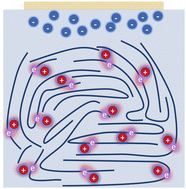
On the fundamentals of organic mixed ionic/electronic conductors
Fabiano, Simone, Flagg, Lucas, Hidalgo Castillo, Tania C., Inal, Sahika, Kaake, Loren G., Kayser, Laure V., Keene, Scott T., Ludwigs, Sabine, Muller, Christian, Savoie, Brett M., Lüssem, Björn, Lutkenhaus, Jodie L., Matta, Micaela, Meli, Dilara, Patel, Shrayesh N., Paulsen, Bryan D., Rivnay, Jonathan, and Surgailis, JokubasJ. Mater. Chem. C, 11, 14527-14539 (2023)linkAbstractThe first Telluride Science meeting (formerly TSRC) on organic mixed ionic and electronic conductors (OMIECs), Oct 3–7, 2022, brought together researchers across the field to understand the fundamental processes and identify out-standing questions related to this exciting class of materials. OMIECs are organic materials that promote the transport of mobile electronic charge carriers while simultaneously supporting ionic transport and ionic–electronic coupling. These properties open up broad areas of applications from energy to bioelectronics. Devices include batteries, supercapacitors, actuators, electrochromic displays, and organic electrochemical transistors (OECTs). They possess the key strengths of traditional organic electronic materials, such as synthetic tunability and low-temperature processing. Despite the recent advances in devices and applications achieved with such materials, many challenges and gaps in understanding remain. These topics hold the key to designing next-generation materials and devices that continue to push the limits of performance and stability and facilitate novel functionality. This perspective aims to summarize the current understanding, conversations, and debates that made this TSRC particularly engaging, enabling new directions and searching for missing pieces of the OMIEC puzzle.

Building a community-driven ecosystem for fast, reproducible, and reusable molecular simulation analysis using mdanalysis
Alibay, Irfan, Barnoud, Jonathan, Beckstein, Oliver, Gowers, Richard J., Loche, Philip R., MacDermott-Opeskin, Hugo, Matta, Micaela, Naughton, Fiona B., Reddy, Tyler, and Wang, LilyBiophysical Journal, 122, 420a (2023)
2022
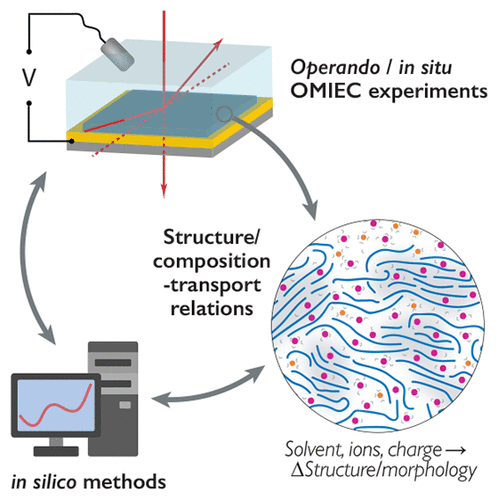
Operando Characterization of Organic Mixed Ionic/Electronic Conducting Materials
Wu, Ruiheng, Matta, Micaela, Paulsen, Bryan D., and Rivnay, JonathanChemical Reviews, 122, 4493-4551 (2022)
2020
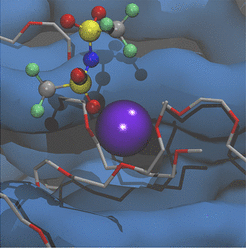
Ion Coordination and Chelation in a Glycolated Polymer Semiconductor: Molecular Dynamics and X-ray Fluorescence Study
Matta, Micaela, Wu, Ruiheng, Paulsen, Bryan D., Petty, Anthony J., Sheelamanthula, Rajendar, McCulloch, Iain, Schatz, George C., and Rivnay, JonathanChemistry of Materials, 32, 7301–7308 (2020)link PDFAbstractOrganic electrochemical transistors (OECTs) are based on the doping of a semiconducting polymer by an electrolyte. Due to their ability to conjugate volumetric ion penetration with high hole mobility and charge density, polythiophenes bearing glycolated side chains have rapidly surged as the highest performing materials for OECTs; amongst them, p(g2T-TT) is amongst those with the highest figure of merit. While recent studies have shown how different doping anions tend to affect the polymer microstructure, only a handful of electrolytes have been tested in mixed conduction devices. Our work provides an atomistic picture of the p(g2T-TT) -electrolyte interface in the ‘off’ state of an OECT, expected to be dominated by cation-polymer interactions. Using a combination of molecular dynamics simulations and X-ray fluorescence, we show how different anions effectively tune the coordination and chelation of cations by glycolated polymers. At the same time, softer and hydrophobic anions such as TFSI and ClO4 are found to preferentially interact with the p(g2T-TT) phase, further enhancing polymer-cation coordination. Besides opening the way for a full study of electrolyte doping mechanisms in operating devices, our results suggest that tailoring the electrolyte for different applications and materials might be a viable strategy to tune the performance of mixed conducting devices.
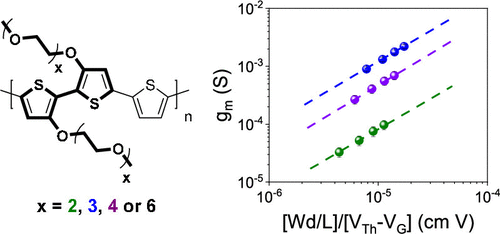
Ethylene Glycol-Based Side Chain Length Engineering in Polythiophenes and its Impact on Organic Electrochemical Transistor Performance
Moser, Maximilian, Savagian, Lisa R., Savva, Achilleas, Matta, Micaela, Ponder, James F., Hidalgo, Tania Cecilia, Ohayon, David, Hallani, Rawad, Reisjalali, Maryam, Troisi, Alessandro, Wadsworth, Andrew, Reynolds, John R., Inal, Sahika, and McCulloch, IainChemistry of Materials, 32, 6618–6628 (2020)link PDFAbstractReplacing the alkyl side chains on conventional semiconducting polymers with ethylene glycol (EG)-based chains is a successful strategy in the molecular design of mixed conduction materials for bioelectronic devices, including organic electrochemical transistors (OECTs). Such polymers have demonstrated the capability to conduct both ionic and electronic charges and can offer superior performance compared to the most commonly used active material, poly(3,4-ethylenedioxythiophene):poly(styrenesulfonate). While many research efforts have been dedicated to optimizing OECT performance through the engineering of the semiconducting polymers’ conjugated backbones, variation of the EG chain length has been investigated considerably less. In this work, a series of glycolated polythiophenes with pendant EG chains spanning two to six EG repeat units was synthesized and the electrochemical and structural characteristics of the resulting films were characterized by experimental means and molecular dynamics simulations. OECTs were fabricated and tested, and their performance showed a strong correlation to the the EG side chain length, thereby elucidating important structure−property guidelines for the molecular design of future channel materials. Specifically, a careful balance in the EG length must be struck during the design of EG-functionalized conjugated polymers for OECTs. While minimizing the EG side chain length appears to boost both the capacitive and charge carrier transport properties of the polymers, the chosen EG side chain length must be kept sufficiently long to induce solubility for processing, and allow for the necessary ion interactions with the conjugated polymer backbone.
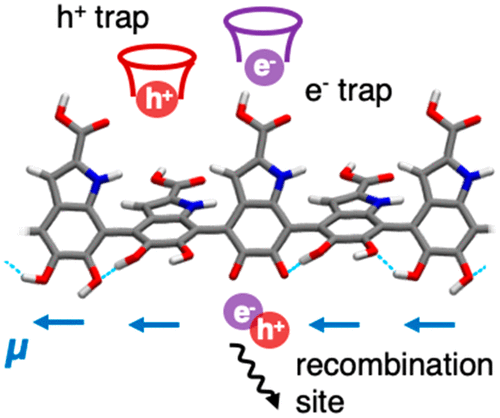
Relation between Local Structure, Electric Dipole, and Charge Carrier Dynamics in DHICA Melanin: A Model for Biocompatible Semiconductors
Matta, Micaela, Pezzella, Alessandro, and Troisi, AlessandroThe Journal of Physical Chemistry Letters, 11, 1045–1051 (2020)link PDFAbstractEumelanins are a family of natural and synthetic pigments obtained by oxidative polymerization of their natural precursors: 5,6-dihydroxyindole and its 2-carboxy derivative (DHICA). The simultaneous presence of ionic and electronic charge carriers makes these pigments promising materials for applications in bioelectronics. In this computational study we build a structural model of DHICA melanin considering the interplay between its many degrees of freedom, and then we examine the electronic structure of representative oligomers. We find that a nonvanishing dipole along the polymer chain sets this system apart from conventional polymer semiconductors, determining its electronic structure, reactivity toward oxidation and localization of the charge carriers. Our work sheds light on previously unnoticed features of DHICA melanin that not only fit well with its radical scavenging and photoprotective properties but also open new perspectives toward understanding and tuning charge transport in this class of materials.
2019
Fluorination Effects on Indacenodithienothiophene Acceptor Packing and Electronic Structure, End-Group Redistribution, and Solar Cell Photovoltaic Response
Aldrich, Thomas J., Matta, Micaela, Zhu, Weigang, Swick, Steven M., Stern, Charlotte L., Schatz, George C., Facchetti, Antonio, Melkonyan, Ferdinand S., and Marks, Tobin J.Journal of the American Chemical Society, , (2019)PDFAbstractIndacenodithienothiophene (IDTT)-based postfullerene electron acceptors, such as ITIC (2,2′-[[6,6,12,12-tetrakis(4-hexylphenyl)-6,12-dihydrodithieno[2,3-d:2′,3′-d′]-s-indaceno[1,2-b:5,6-b′]dithiophene-2,8-diyl]-bis[methylidyne(3-oxo-1H-indene-2,1(3H)-diylidene)]]bis[propanedinitrile]), have become synonymous with high power conversion efficiencies (PCEs) in bulk heterojunction (BHJ) polymer solar cells (PSCs). Here we systematically investigate the influence of end-group fluorination density and positioning on the physicochemical properties, single-crystal packing, end-group redistribution propensity, and BHJ photovoltaic performance of a series of ITIC variants, ITIC-nF (n = 0, 2, 3, 4, and 6). Increasing n from 0 → 6 contracts the optical bandgap, but only marginally lowers the LUMO for n > 4. This yields enhanced photovoltaic short-circuit current density and good open-circuit voltage, so that ITIC-6F achieves the highest PCE of the series, approaching 12% in blends with the PBDB-TF donor polymer. Single-crystal diffraction reveals that the ITIC-nF molecules cofacially interleave with ITIC-6F having the shortest \pi-\pi distance of 3.28 Å. This feature together with ZINDO-level computed intermolecular electronic coupling integrals as high as 57 meV, and B3LYP/DZP-level reorganization energies as low as 147 meV, rival or surpass the corresponding values for fullerenes, ITIC-0F, and ITIC-4F, and track a positive correlation between the ITIC-nF space-charge limited electron mobility and n. Finally, a heretofore unrecognized solution-phase redistribution process between the 2-(3-oxo-indan-1-ylidene)-malononitrile-derived end-groups (EGs) of IDTT-based NFAs, i.e., EG 1 -IDTT-EG 1 + EG 2 -IDTT-EG 2 ⇄ 2 EG 1 -IDTT-EG 2 , with implications for the entire ITIC PSC field, is identified and mechanistically characterized, and the effects on PSC performance are assessed.
Photovoltaic Blend Microstructure for High Efficiency Post-Fullerene Solar Cells. To Tilt or Not To Tilt?
Wang, Gang, Swick, Steven M., Matta, Micaela, Mukherjee, Subhrangsu, Strzalka, Joseph W., Logsdon, Jenna Leigh, Fabiano, Simone, Huang, Wei, Aldrich, Thomas J., Yang, Tony, Timalsina, Amod, Powers-Riggs, Natalia, Alzola, Joaquin M., Young, Ryan M., DeLongchamp, Dean M., Wasielewski, Michael R., Kohlstedt, Kevin L., Schatz, George C., Melkonyan, Ferdinand S., Facchetti, Antonio, and Marks, Tobin J.Journal of the American Chemical Society, 141, 13410–13420 (2019)link PDFAbstractAchieving efficient polymer solar cells (PSCs) requires a structurally optimal donor-acceptor heterojunction morphology. Here we report the combined experimental and theoretical characterization of a benzodithiophene-benzothiadiazole donor polymer series (PBTZF4-R; R = alkyl substituent) blended with the non-fullerene acceptor ITIC-Th and analyze the effects of substituent dimensions on blend morphology, charge transport, carrier dynamics, and PSC metrics. Varying substituent dimensions has a pronounced effect on the blend morphology with a direct link between domain purity, to some extent domain dimensions, and charge generation and collection. The polymer with the smallest alkyl substituent yields the highest PSC power conversion efficiency (PCE, 11%), reflecting relatively small, high-purity domains and possibly benefiting from "matched" donor polymer-small molecule acceptor orientations. The distinctive morphologies arising from the substituents are investigated using molecular dynamics (MD) simulations which reveal that substituent dimensions dictate a well-defined set of polymer conformations, in turn driving chain aggregation and, ultimately, the various film morphologies and mixing with acceptor small molecules. A straightforward energetic parameter explains the experimental polymer domain morphological trends, hence PCE, and suggests strategies for substituent selection to optimize PSC materials morphologies.
2018
Application of Rubrene Air-Gap Transistors as Sensitive MEMS Physical Sensors
Pereira, Marco J., Matta, Micaela, Hirsch, Lionel, Dufour, Isabelle, Briseno, Alejandro, Gali, Sai Manoj, Olivier, Yoann, Muccioli, Luca, Crosby, Alfred, Ayela, Cédric, and Wantz, GuillaumeACS Applied Materials and Interfaces, 10, 41570–41577 (2018)PDFAbstractMicro-electromechanical systems (MEMS) made of organic materials have attracted efforts for the development a new generation of physical, chemical, and biological sensors, for which the electromechanical sensitivity is the current major concern. Here, we present an organic MEMS made of a rubrene single-crystal air-gap transistor. Applying mechanical pressure on the semiconductor results in high variations in drain current: an unparalleled gauge factor above 4000 has been measured experimentally. Such a high sensitivity is induced by the modulation of charge injection at the interface between the gold electrode and the rubrene semiconductor as an unusual transducing effect. Applying these devices to the detection of acoustic pressure shows that force down to 230 nN can be measured with a resolution of 40 nN. This study demonstrates that MEMS based on rubrene air-gap transistors constitute a step forward in the development of high-performance flexible sensors.
Unusual electromechanical response in rubrene single crystals
Matta, Micaela, Pereira, Marco José, Gali, Sai Manoj, Thuau, Damien, Olivier, Yoann, Briseno, Alejandro, Dufour, Isabelle, Ayela, Cedric, Wantz, Guillaume, and Muccioli, LucaMaterials Horizons, 5, 41–50 (2018)link PDFAbstractMultiscale modeling and experimental measurements highlight the strong coupling between mechanical stress and mobility along the two in-plane orthogonal crystalline directions in rubrene FETs.
Closely packed, low reorganization energy \pi-extended postfullerene acceptors for efficient polymer solar cells
Swick, Steven M, Zhu, Weigang, Matta, Micaela, Aldrich, Thomas J, Harbuzaru, Alexandra, Navarrete, J. Teodomiro Lopez, Ortiz, Rocio Ponce, Kohlstedt, Kevin L, Schatz, George C, Facchetti, Antonio, Melkonyan, Ferdinand S, and Marks, Tobin JProceedings of the National Academy of Sciences of the United States of America, 115, E8341–E8348 (2018)link PDFAbstractNew organic semiconductors are essential for developing inexpensive, high-efficiency, solution-processable polymer solar cells (PSCs). PSC photoactive layers are typically fabricated by film-casting a donor polymer and a fullerene acceptor blend, with ensuing solvent evaporation and phase separation creating discrete conduits for photogenerated holes and electrons. Until recently, n-type fullerene acceptors dominated the PSC literature; however, indacenodithienothiophene (IDTT)-based acceptors have recently enabled remarkable PSC performance metrics, for reasons that are not entirely obvious. We report two isomeric IDTT-based acceptors 3,9-bis(2-methylene-(3-(1,1-dicyanomethylene)-benz-(5, 6)indanone))-5,5,11,11-tetrakis(4-nonylphenyl)-dithieno[2,3-d:2′,3′-d′]-s-indaceno[1,2-b:5,6-b′]di-thiophene (ITN-C9) and 3,9-bis(2-methylene-(3-(1,1-dicyanomethylene)-benz(6,7)indanone))-5,5,11,11-tetrakis (4-nonylphenyl)-dithieno[2,3-d:2′,3′-d′]-s-indaceno[1,2-b:5,6-b′]dithio-phene (ITzN-C9) that shed light on the exceptional IDTT properties vis-à-vis fullerenes. The neat acceptors and blends with fluoropolymer donor poly[4,8-bis[5-(2- ethylhexyl)-4-fluoro-2-thienyl]benzo[1,2-b:4,5-b′]dithiophene2,6-diyl]-alt-[2,5-thiophenediyl[5,7-bis(2-ethylhexyl)-4,8-dioxo4H,8H-benzo[1,2-c:4,5-c′]dithiophene-1,3-diyl]] (PBDB-TF) are investigated by optical spectroscopy, cyclic voltammetry, thermogravimetric analysis, differential scanning calorimetry, single-crystal X-ray diffraction, photovoltaic response, space-charge-limited current transport, atomic force microscopy, grazing incidence wide-angle X-ray scattering, and density functional theory-level quantum chemical analysis. The data reveal that ITN-C9 and ITzN-C9 organize such that the lowest unoccupied molecular orbital-rich end groups have intermolecular \pi−\pi distances as close as 3.31(1) Å, with electronic coupling integrals as large as 38 meV, and internal reorganization energies as small as 0.133 eV, comparable to or superior to those in fullerenes. ITN-C9 and ITzN-C9 have broad solar-relevant optical absorption, and, when blended with PBDB-TF, afford devices with power conversion efficiencies near 10%. Performance differences between ITN-C9 and ITzN-C9 are understandable in terms of molecular and electronic structure distinctions via the influences on molecular packing and orientation with respect to the electrode.
Ambipolarity and Dimensionality of Charge Transport in Crystalline Group 14 Phthalocyanines: A Computational Study
Gali, Sai Manoj, Matta, Micaela, Lessard, Benoît H., Castet, Frédéric, and Muccioli, LucaJournal of Physical Chemistry C, 122, 2554–2563 (2018)link PDFAbstractThe charge transport properties of ten group 14 phthalocyanine crystals are investigated by means of kinetic Monte Carlo simulations based on experimental X-ray structures. All investigated materials are predicted to exhibit an ambipolar semiconducting behavior, with hole and electron mobilities lying in the range 0.1-1 cm2 V-1 s-1, showing their potential for organic electronic devices. The simulations also provide evidence that the dimensionality of charge transport in these materials can be finely tuned by substituting the phenoxy axial groups with fluorine atoms and by varying their number and positions; a complete substitution gives rise to two-dimensional transport for both electrons and holes. Most remarkably, one of the investigated compounds that incorporates iodine-phenoxy groups as axial substituents exhibits the largest mobilities for both electrons and holes, owing to large intermolecular couplings and low reorganization energies, and thus emerges as a highly promising one-dimensional semiconductor.
2017
Molecular-scale shear response of the organic semiconductor -DBDCS (100) surface
Álvarez-Asencio, Rubén, Moreno-Ramírez, Jorge S., Pimentel, Carlos, Casado, Santiago, Matta, Micaela, Gierschner, Johannes, Muccioli, Luca, Yoon, Seong-Jun, Varghese, Shinto, Park, Soo Young, Gnecco, Enrico, and Pina, Carlos M.Physical Review B, 96, 115422 (2017)linkAbstract\textcopyright 2017 American Physical Society. In this work we present friction-force microscopy (FFM) lattice-resolved images acquired on the (100) facet of the semiconductor organic oligomer (2Z,2′Z)-3,3′-(1,4-phenylene)bis(2-(4-butoxyphenyl)acrylonitrile) (β-DBDCS) crystal in water at room temperature. Stick-slip contrast, lateral contact stiffness, and friction forces are found to depend strongly on the sliding direction due to the anisotropic packing of the molecular chains forming the crystal surface along the [010] and [001] directions. The anisotropy also causes the maximum value of the normal force applicable before wearing to increase by a factor of 3 when the scan is performed along the [001] direction on the (100) face. Altogether, our results contribute to achieving a better understanding of the molecular origin of friction anisotropy on soft crystalline surfaces, which has been often hypothesized but rarely investigated in the literature.
Pressure sensor based on organic single crystal air-gap transistor
Pereira, M.J., Ayela, C., Hirsch, L., Dufour, I., Briseno, A., Matta, M., Olivier, Y., Muccioli, L., Crosby, A., and Wantz, G.In TRANSDUCERS 2017 - 19th International Conference on Solid-State Sensors, Actuators and Microsystems, , (2017)Abstract\textcopyright 2017 IEEE. With the development of new technologies, researchers have recently focused their interest on flexible electronics to improve the interaction between users and devices. In this context, integrated ultra-low-pressure sensors remain a technological challenge. Here, we show that organic single crystal-based air-gap transistors fabricated by soft lithography are extremely sensitive to mechanical strain and pressure. When low forces are applied to the suspended semiconducting crystal (rubrene), the gated transistors show that drain currents as output signals are extremely sensitive to the deformations. Incredibly high gauge factors, over 4000, are measured using this technique. Further investigation shows that the contact resistance at the rubrene-gold interface is responsible for the high sensing performances. Such a platform is also able to detect sound waves with high sensitivity, making these simple devices suitable for applications in pressure sensing.
2016
2015
Changes of the Molecular Structure in Organic Thin Film Transistors during Operation
Liscio, Fabiola, Ferlauto, Laura, Matta, Micaela, Pfattner, Raphael, Murgia, Mauro, Rovira, Concepció, Mas-Torrent, Marta, Zerbetto, Francesco, Milita, Silvia, and Biscarini, FabioThe Journal of Physical Chemistry C, 119, 15912–15918 (2015)link PDFAbstractThin films of organic semiconductors have been widely studied at different length scales for improving the electrical response of devices based on them. Hitherto, a lot of knowledge has been gained about how molecular packing, morphology, grain boundaries, and defects affect the charge transport in organic thin film transistors. However, little is known about the impact of an electric field on the organic semiconductor microstructure and the consequent effect on the device performances. To fill this gap, we investigated the evolution of the structure of pentacene thin film transistors during device operation by in situ real time X-ray diffraction measurements and theoretical calculations. We observed for the first time the occurrence of a reversible structural strain taking place during the bias application mainly due to reorientation at the terrace edges of monolayer islands under the effect of electrical field. Strain exhibits the same trend of the threshold voltage hinting to the existence of a direct correlation between the phenomenon of bias stress and the structural modification. Thin films of organic semiconductors have been widely studied at different length scales for improving the electrical response of devices based on them. Hitherto, a lot of knowledge has been gained about how molecular packing, morphology, grain boundaries, and defects affect the charge transport in organic thin film transistors. However, little is known about the impact of an electric field on the organic semiconductor microstructure and the consequent effect on the device performances. To fill this gap, we investigated the evolution of the structure of pentacene thin film transistors during device operation by in situ real time X-ray diffraction measurements and theoretical calculations. We observed for the first time the occurrence of a reversible structural strain taking place during the bias application mainly due to reorientation at the terrace edges of monolayer islands under the effect of electrical field. Strain exhibits the same trend of the threshold voltage hinting to the existence of a direct correlation between the phenomenon of bias stress and the structural modification.
2013
A Strongly Emitting Liquid-Crystalline Derivative of Y 3 N@C 80 : Bright and Long-Lived Near-IR Luminescence from a Charge Transfer State
Toth, Kalman, Molloy, Jennifer K, Matta, Micaela, Heinrich, Benoît, Guillon, Daniel, Bergamini, Giacomo, Zerbetto, Francesco, Donnio, Bertrand, Ceroni, Paola, and Felder-Flesch, DelphineAngewandte Chemie International Edition, 52, 12303–12307 (2013)link PDFAbstractGreat balls of fire: C60 and Y3 N@C80 were connected to the same oligo(phenyleneethynylene) unit to investigate their structural and photophysical properties. NMR investigations revealed a fulleroid structure for the Y3 N@C80 derivative, and both dyads gave rise to columnar phases with core-shell cylinders. The black and gray spheres represent the fullerene core units of the Y3 N@C80 derivative, which is an ideal candidate to be involved in energy and electron transfer processes.